As warm atmospheric rivers slide gradually southward along Pacific Coast, a return to rain and end to tule fog in NorCal later this week–but don’t expect much mountain snow
An exceptional temperature inversion: Weeks of tule fog and damp chill in the Central Valley amid a record-warm airmass more broadly across American West and California
Well, it sure has been another dramatic couple of weeks when it comes to Western U.S. weather! But exactly what the drama has been varies widely from place to place–in some cases, even rather dramatically over just a couple of thousand feet of elevation or a horizontal mile or two. For several weeks, a persistent and fairly strong mid-level ridge of high pressure has kept (most of) California as well as most of the Southwest rain/snow-less and much warmer than usual. As the ridge has persisted, record or near-record warm and daytime and/or nighttime temperatures have occurred virtually every day in December so far somewhere in the West, particularly inland and at higher elevations. So for around 75% of the land area of the West, historic warmth and December sun has been the rule for the last 3 weeks. But there have been two (quite major) exceptions.
The first is California’s Central Valley (as well as portions of the northern and eastern SF Bay Area)–where a remarkably long episode of nearly unbroken tule fog (as well as what I’m officially calling “tule stratus,” when the moisture layer is still dense but not maximally so right at the surface) has kept conditions consistently cold, clammy, and damp. This persistent fog and stratus layer almost exclusively relegated to the Central Valley has been facilitated by a wet autumn (which added moisture to the soil, which then was available to evaporate into near-surface air) followed by the highly persistent ridge, which has exerted a modest but near-constant downward motion on the overlying atmosphere (i.e., through “subsidence). This, in turn, has allowed moisture to remain trapped in a shallow layer less than 2,000 feet deep near the surface, which has persisted for weeks now via self-reinforcing feedbacks, and also for the development of an extremely warm layer of air immediately atop the fog layer in the form of an extreme temperature inversion (i.e., a condition where temperature increases with height, instead of decreasing). This inversion has led to some pretty absurd temperature contrasts, both vertically, where the temperature differential between the valley floor and the immediately surrounding foothills/coastal mountains just 1,000-2,000 feet above has sometimes been in excess of 30-35F in recent days. (It has commonly been only in the low 40s F in the afternoons throughout much of the Central Valley for many days, yet as warm as 70-80F just 1,500 feet above and a couple of miles away horizontally!) This means that while denizens of places like Sacramento, Stockton, Fresno, and other Valley population centers have been shivering through a period featuring one of the chilliest daytime high temperatures in recent memory (decades, in some spots), other locations just a mile or two away have been literally record warm. Indeed: so far this December, it has often been warmer (even at night!) at locations a mile up in the Sierra Nevada than it has been in Sacramento–a truly bizarre statistic made possible by this incredibly strong and persistent temperature inversion and high pressure aloft. Meanwhile, in SoCal, it has felt like “July in December”–with many days in a row of mostly sunny and dry conditions with afternoon high temperatures ranging from the 70s to 80s (and even a few 90s in the hottest spots).
The second place where it has not been consistently warm and dry is the Pacific Northwest–where a series of very moist and very warm atmospheric rivers in recent days have brought (and continue to bring) widespread and in some cases major to record-breaking flooding on some rivers, as well as widespread landslides. (Well, I guess the “warm” part was still true even here!) While the Pacific Northwest is often wetter than usual during notable ENSO cool-phase winters, this recent episode has been remarkable even in that context given the anomalous warmth that has coincided with the moisture–with very high snow levels in the Cascades and Coast Ranges yielding snowpack that is presently near zero in many locations despite extremely wet conditions.
Anomalous to record warm airmass will persist across much of the U.S. West as warm and moist atmospheric rivers begin to make southward progress, returning rain and ending persistent NorCal fog and bringing additional flood risk to PacNW/B.C.
Over the coming days, a nearly continuous stream of generally quite warm atmospheric rivers (including some of the “Mango/Pineapple Express” variety, with some level of moisture connection to the deep subtropical Pacific) will affect some portion of the Pacific Coast of North America. The next will affect the Pacific Northwest once again overnight tonight into Monday, bringing renewed flooding and landslide risk to Washington and British Columbia. This one will be aimed a bit farther north than the ones last week, so flood risk will be slightly reduced in WA and increased in B.C. with this round, though the risk of landslides will be growing region-wide as heavy rainfall continued on now completely saturated slopes.
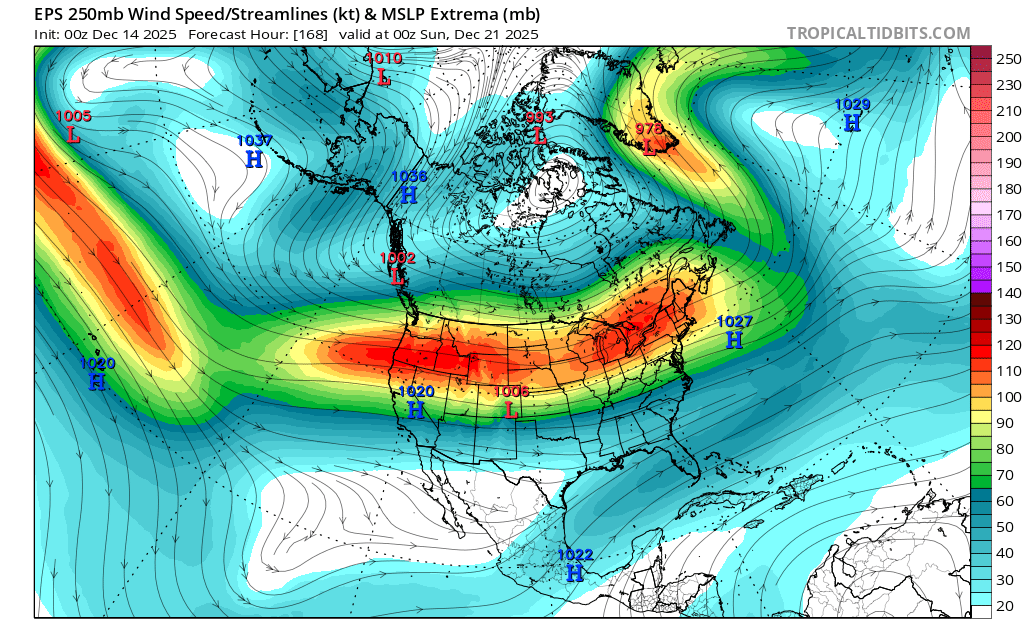
As the week progresses, the ridge over the interior West will very slowly begin to budge–shifting eastward at a painstakingly slow yet perceptible pace. As it does so, an extremely warm (in some cases record warm) airmass will persist over the interior West and even portions of California. Coincident with this eastward shift, however, the Pacific jet stream will slowly sag southward over Oregon–allowing the atmospheric river parade to aim somewhat farther southward. This will mean that Oregon should get plenty wet, and initially the North Coast of CA could even see some relatively gentle rainfall by Mon-Tue. By later in the week, this evolution will continue to incrementally allow the Pacific storm track to inch southward, eventually allowing a moist plume associated with the warm atmospheric river corridor to make it as far south as the Interstate 80 corridor/SF Bay to Tahoe region by midweek. Right now, this looks like it will be a fairly gradual process and this is not the kind of pattern that will generate dramatically stormy weather in California. Instead, widespread light to moderate warm rains will develop increasingly far south over NorCal–affecting regions from about the SF Bay region northward (and maybe a bit south of that by mid-late week).
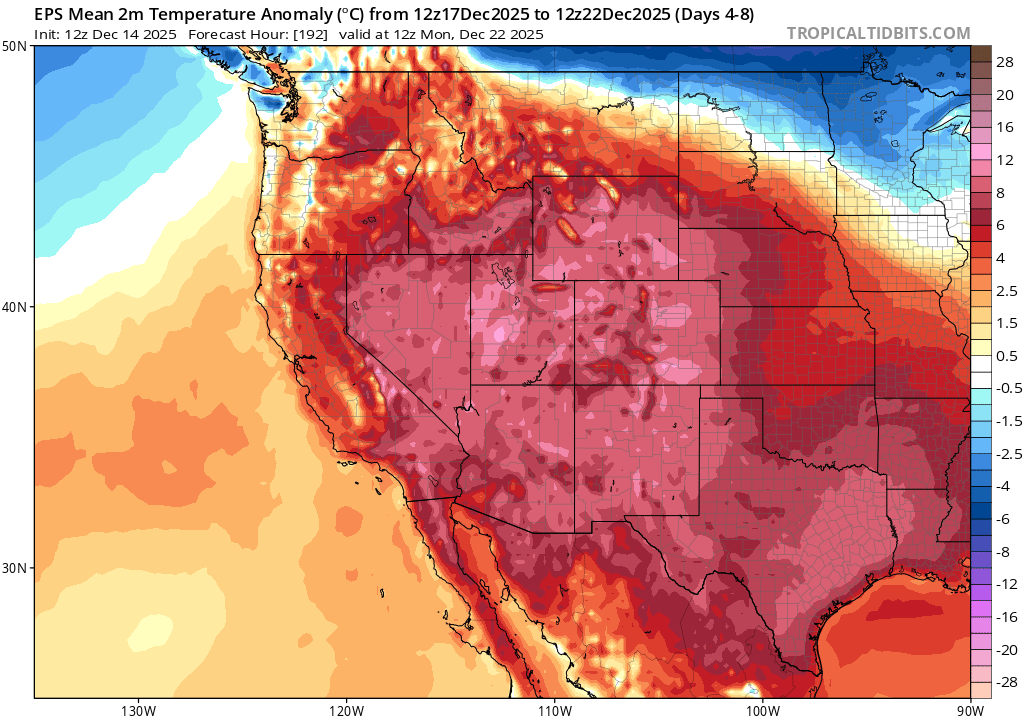
In the Central Valley and Bay Area, this pattern will probably (and at last!) be capable of breaking up the persistent temperature inversion and tule fog layer. Therefore, despite the arrival of a deeper cloud layer and eventually some rain, temperatures will likely warm by 10-20F in some areas once the cold lower levels get scoured out and the warmer subtropical airmass arrives. So it won’t be warm and sunny most of the time (though there might actually be longer sunny breaks than have occurred recently in these areas), but it’s going to feel positively balmy by comparison to the past 3 weeks. We do still have at least 2-3 more days of fog to go in some areas (especially down in the southern San Joaquin Valley; the fog will lift first in the north and move away from SF Bay), but an end is finally in sight.
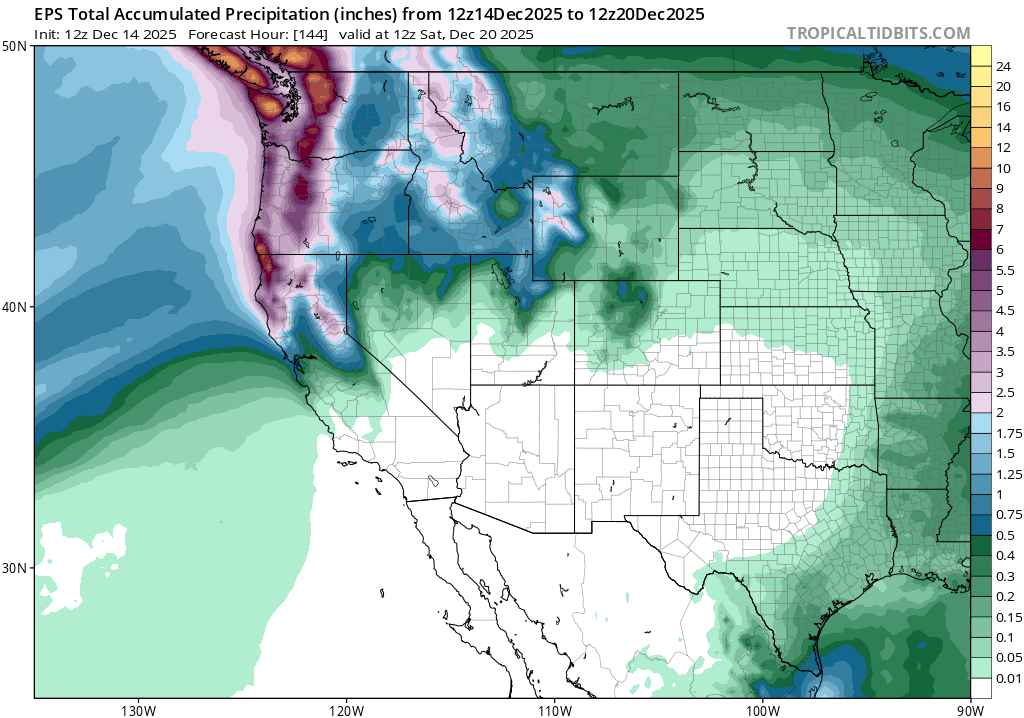
Near-record or record low snowpack in Sierra Nevada may persist for at least another 7-10 days despite onset of precipitation, since it’ll be nearly all rain below 7,000-8,000 feet (and locally 9,000-10,000 feet)
This airmass, however, will remain exceptionally warm despite the moisture and rainfall–so even in the mountains, precipitation will likely fall as rain no lower than 7,000-8,000 feet (and it is possible that little appreciable snow falls much below 9,000-10,000 feet over the next 7-10 days given the extremely warm antecedent airmass and the continued very warm subtropical origins of the upcoming one). Sierra snowpack is currently at extremely low levels for mid-December in the central and northern part of the mountain range (generally under 20% of average, and locally ~0% of average) thanks to a lack of recent precipitation and very warm temperatures above the steep temperature inversion. In the Southern Sierra, it has also been very warm and dry as of late but there was so much early-season precipitation in Sep-Nov (record-breaking amounts, in some spots!) that locations above 7,000 feet still have some decent snow on the ground (a “whopping” 40-50% of the mid-December average). But there are some notable locations in the central and northern Sierra that essentially have no snow on the ground at all right now–including the Central Sierra Snow Lab (elev. ~6,800ft), which is currently at a record-tying ~0% of average for the calendar date. In fact, I actually expect what little snowpack is currently present to largely disappear this week as warm rain falls on top of it; there may be some patches left above 8,000 or 9,000 feet, but 7-10 days from now I expect the Sierra snow situation will actually be worse than today (despite the upcoming very warm precipitation).

I will say that it is still early in the snow accumulation season–comebacks from terrible December snowpacks have certainly occurred in the past, and could well occur this year. (There is even a decent prospect of some colder storms closer to New Year’s–see the section below). But the general West-wide lack of robust mountain snowpack heading into the second half of December, for the time being, remains somewhere between remarkable and record-breaking (depending on location and definitions).
No notably cold airmass on the horizon for California through end of Dec, but stormier weather might return to entire state (including SoCal) depending on details of eastward ridge shift
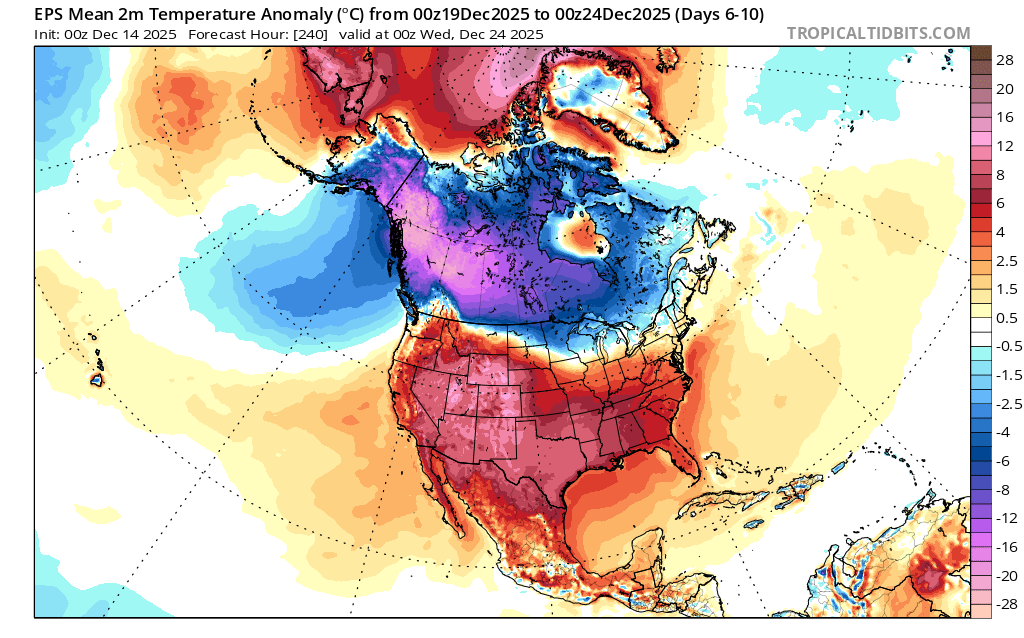
Despite a very cold airmass trapped up in Western Canada (where there have even been a few daily record lows in recent days), I don’t really see any clear sign that it will make much progress into the Western U.S. between now and the end of the year. Conditions will cool back closer to seasonal averages in the Pacific Northwest during this period, though will remain greatly elevated across most of the interior West (including most of California). But the ensembles are currently hinting this could become quite a storm period progressively farther south along the West Coast: first beginning in NorCal later this week, then possibly/probably extending into SoCal by the middle of the following week (so 7-10 days from now). In fact, as a trough begins to develop just west of CA toward the end of December, there will be the possibility of some pretty strong statewide storms (unfortunately right around the height of the winter holiday travel season). Right now, it’s still too early to say much about the details, but here are some early thoughts regarding the timeline:
- Light to moderate warm rains arrive in NorCal this week, with high temperatures preventing much mountain snow below 8,000 feet
- Heavier rainfall (still warm) may affect northern and central CA starting in about a week (with very high mountain snow levels continuing)
- Stronger statewide storm activity may occur in the 7-14 day window, with more widespread & intense rainfall/strong winds/local thunderstorms/mountain snow
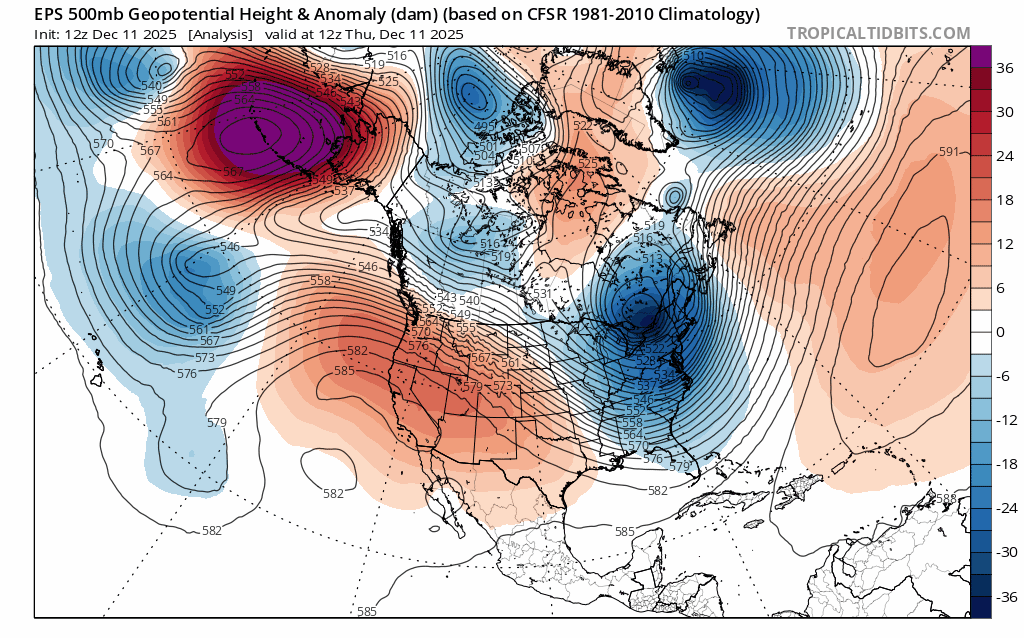
Initially, the risk of flooding will be low or even negligible (despite some heavier mountain/orographic rainfall) because it has been so dry recently and rivers are running low for December. As stronger and more widespread storm activity (though, again, still likely warm and atmospheric river-associated) arrive in the 7-10 day window, there could be an increasing risk of flooding as soils become saturated and high snow levels increase runoff rates at higher elevations. There might be a strong wind event or two in this window as well depending on the exact jet stream structure and the presence of any nearby surface lows; we shall see. Also notable, amid this unusually moist and warm airmass, is the potential that thunderstorms could develop at some point and potentially not be relegated to the usual timing along/behind the cold front (i.e., there are some model members suggesting convective activity developing while CA is in the warm sector–a testament to the unusually warm/moist/dynamic airmass that might be in play). I’ll be following the details on social media and especially in my live virtual office hour sessions, so be sure to tune in!
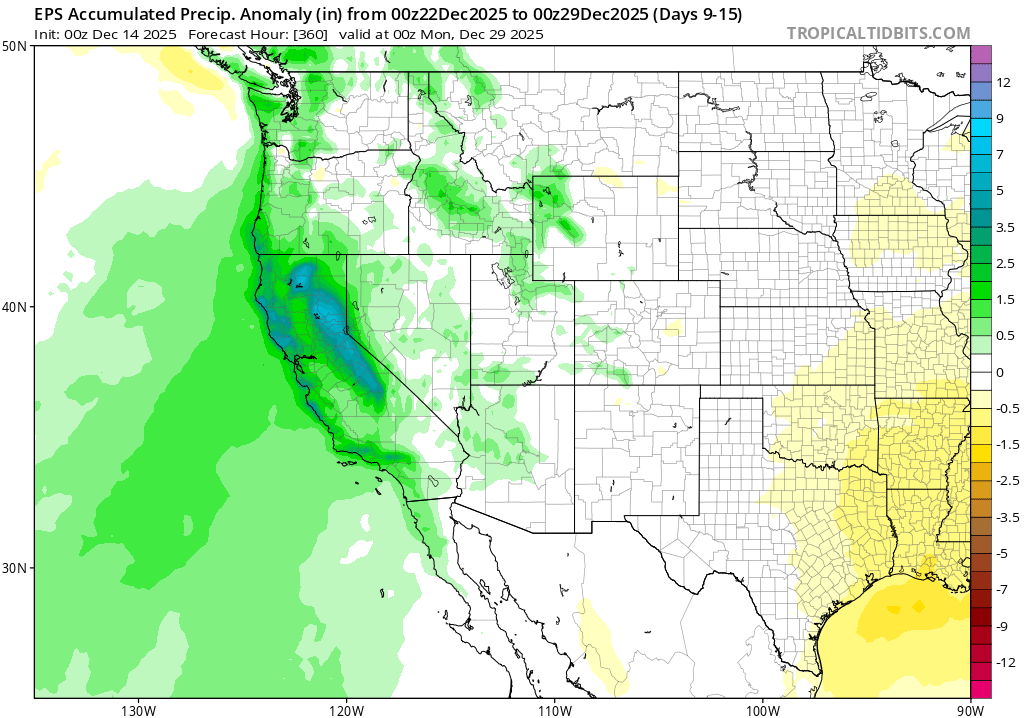
Longer-form video content for your consideration: A recording of last week’s hurricane-related webinar, plus a new live virtual office hour this week to discuss upcoming warm atmospheric rivers along Pacific Coast
In case you missed it live last week (and I would not blame you, as it took place at 7am Pacific Time to accommodate those in eastern U.S. and international time zones!), you might be interested in the recording of a one hour webinar (hosted by Reask) on the science behind as well as the implications of more rapidly intensifying hurricanes in a warming world. You can view the recording here (just scroll to the bottom of the page and click “watch on demand.”)
I’ll also be hosting a “lunch hour” live virtual weather and climate office hour on Tuesday, December 16th at noon Pacific Time. I’ll be discussing the continued onslaught of very warm atmospheric river storms and what impacts this will have for the Pacific Northwest and British Columbia in terms of flood risk, as well as California in terms of a return to precipitation (at least in NorCal) and what might be in store for SoCal later in December. See you then!